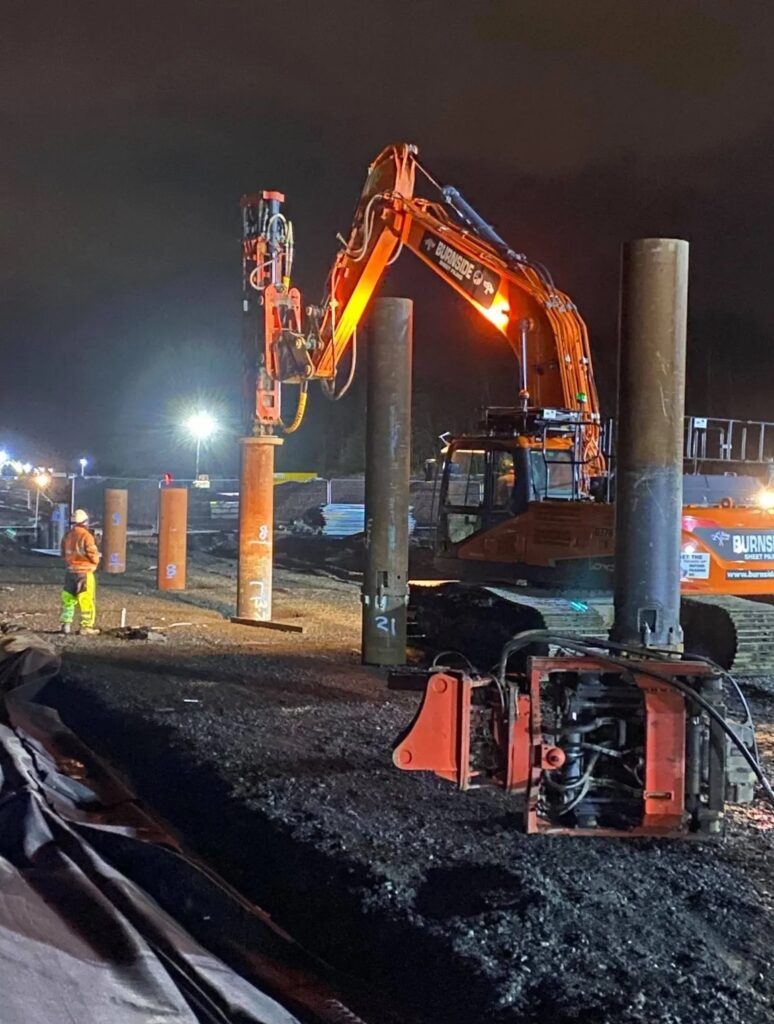TUBULAR PILING
Strength and Stability: Superior Tubular Piling Services for Your Construction Projects in the UK
TUBULAR PILING
Burnside Plant is delighted to offer the latest techniques and technology in tubular pilings installations. We have completed many tubular piling installation projects across Scotland and the United Kingdom and have built a reputation for high quality work and a professional, full service approach to the design, construction, installation and testing of all our piling projects.
While tubular pilings are often found in offshore structures, including oil and gas platforms, wind turbines, and subsea pipelines – these structures rely on tubular piles that are driven into the seabed, providing a stable foundation. However, tubular pilings have many uses for on shore installation and domestic and commercial construction projects of all kinds. Bridge construction also makes use of tubular piling installations to support bridge piers and abutments. The piles are driven into the ground, ensuring a strong and stable foundation for the bridge.
In the construction of high-rise buildings, tubular piling installations play a crucial role in supporting the foundations. By driving piles deep into the ground, a robust and stable foundation is created for the building.
Industrial facilities, such as power plants and manufacturing plants, benefit from tubular piling installations. These piles are driven deep into the ground using our own fleet of the latest machinery, establishing a stable foundation capable of supporting heavy equipment and machinery.

Let's Connect! We're Ready to Meet Your Construction Needs
Tubular piling installations are better suited to these uses than other types of piling installations for several reasons:
- Load-bearing capacity: Tubular piles have a high load-bearing capacity, making them suitable for supporting heavy structures and equipment.
- Resistance to corrosion: Tubular piles are typically made from steel, which has good resistance to corrosion in marine environments and other harsh conditions.
- Durability: Tubular piles are designed to withstand the forces and stresses associated with driving and installation, as well as the environmental conditions they are exposed to.
- Adaptability: Tubular piles can be installed in a variety of soil conditions, including hard and rocky soils, making them a versatile solution for a range of applications.
Tubular piling installations from Burnside Plant are a reliable and effective solution for supporting heavy structures and equipment in a range of applications. They offer high load-bearing capacity, resistance to corrosion, durability, and adaptability, making them well-suited to the demands of these applications no matter the scale of the project.
A tubular piling serves as a deep foundation element for supporting substantial structures and equipment. It comprises a hollow steel pipe that is driven or drilled deeply into the ground, transferring the structure’s load to the underlying soil or rock.
The installation of tubular piles involves several steps. First, a site investigation is conducted to assess the soil and rock conditions at the installation site. This information guides the design of the pile system, tailored to meet project-specific requirements.
Pile driving follows the site investigation. Hydraulic hammers or vibratory drivers, mounted on cranes or piling rigs, are used to drive the tubular piles into the ground. The pile is gradually pushed to the desired depth, which can vary from tens to hundreds of feet, depending on the project’s specifications.
Reinforcement may be applied to the installed pile, involving the addition of rebar or steel bars to enhance its strength and stability.
Grouting may be carried out by injecting grout into the space between the pile and the surrounding soil or rock. This process contributes to additional support and stability.
To ensure the piles’ capability to handle the required loads, testing is conducted after installation. Load tests may be performed by applying a known load to the pile and measuring its deflection or settlement.
Overall, the installation of tubular piles requires specialised equipment and experienced personnel to ensure proper installation and performance. The specific installation process will depend on the site conditions, pile design, and project requirements.
Piling installation can involve several safety hazards that need to be managed to ensure worker safety and minimise risks to the public. One of the primary safety considerations is equipment safety. The equipment used for piling installation, such as cranes and pile driving hammers, must be regularly inspected and well-maintained to ensure they are safe to operate. The operators of the equipment must also be adequately trained and qualified to work with the equipment safely.
Another safety consideration is site safety. Piling sites must be secured and marked to prevent unauthorised access, and adequate signage must be in place to warn workers and the public of potential hazards. Excavation safety is also important, and excavations for pile installation must be shored, sloped, or benched to prevent cave-ins or collapses. Workers must be adequately trained and equipped to work safely in excavations.
